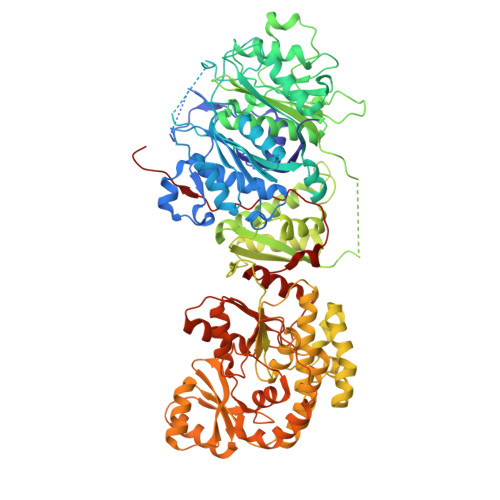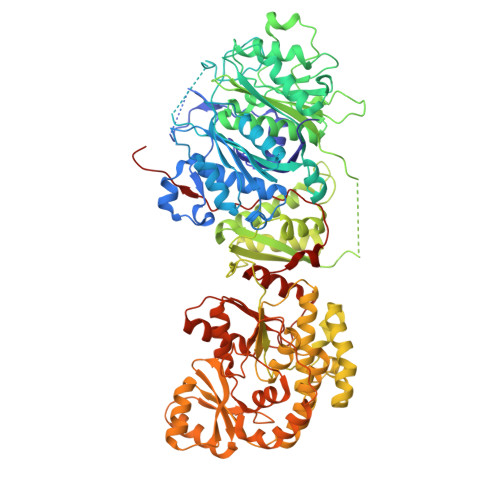Mycocerosic acid synthase exemplifies the architecture of reducing polyketide synthases.
Herbst, D.A., Jakob, R.P., Zahringer, F., Maier, T.(2016) Nature 531: 533-537
- PubMed: 26976449
- DOI: https://doi.org/10.1038/nature16993
- Primary Citation of Related Structures:
5BP1, 5BP2, 5BP3, 5BP4 - PubMed Abstract:
Polyketide synthases (PKSs) are biosynthetic factories that produce natural products with important biological and pharmacological activities. Their exceptional product diversity is encoded in a modular architecture. Modular PKSs (modPKSs) catalyse reactions colinear to the order of modules in an assembly line, whereas iterative PKSs (iPKSs) use a single module iteratively as exemplified by fungal iPKSs (fiPKSs). However, in some cases non-colinear iterative action is also observed for modPKSs modules and is controlled by the assembly line environment. PKSs feature a structural and functional separation into a condensing and a modifying region as observed for fatty acid synthases. Despite the outstanding relevance of PKSs, the detailed organization of PKSs with complete fully reducing modifying regions remains elusive. Here we report a hybrid crystal structure of Mycobacterium smegmatis mycocerosic acid synthase based on structures of its condensing and modifying regions. Mycocerosic acid synthase is a fully reducing iPKS, closely related to modPKSs, and the prototype of mycobacterial mycocerosic acid synthase-like PKSs. It is involved in the biosynthesis of C20-C28 branched-chain fatty acids, which are important virulence factors of mycobacteria. Our structural data reveal a dimeric linker-based organization of the modifying region and visualize dynamics and conformational coupling in PKSs. On the basis of comparative small-angle X-ray scattering, the observed modifying region architecture may be common also in modPKSs. The linker-based organization provides a rationale for the characteristic variability of PKS modules as a main contributor to product diversity. The comprehensive architectural model enables functional dissection and re-engineering of PKSs.
Organizational Affiliation:
Department Biozentrum, University of Basel, Klingelbergstrasse 50/70, 4056 Basel, Switzerland.
















